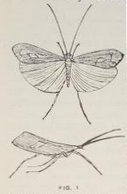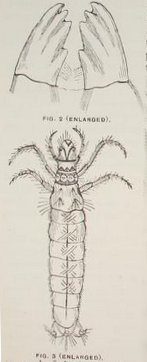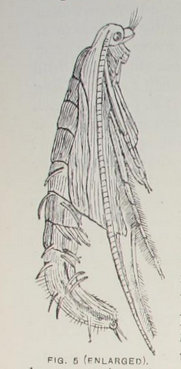

|
The Parents' ReviewA Monthly Magazine of Home-Training and Culture"Education is an atmosphere, a discipline, a life." ______________________________________ Pages for the Children
Happy Days I. It was a June day. The sun ought to have been shining, a warm breeze ought to have been blowing. Alas! all clouds, no sun, a cold strong wind--a most disappointing day! and this was the day on which we had planned our expedition. Wise friends said, "Put it off: you will catch cold;" but then, you see, we were naturalists, and what can damp the ardour of the naturalist,--especially a child-naturalist, who is just beginning to discover what an altogether wonderful and beautiful world this is? "No, we must go," said our little eight-year-old friend. So we went, leaving behind us the dirty, smoky town, driving right away into the country to a quiet, lonely pond. This pond was the goal of our expedition: we meant to find out the secrets of some of the strange little creatures who loved this watery home. We were going to peep into their houses, and ask them all sorts of curious questions. We thought perhaps we should not learn all we wished to know in the hour or two we were at the pond; so we took with us large bottles with string handles, such as little boys take when they go fishing for minnows or catching tadpoles; into these bottles we intended to put our treasures, and so carry them home. The pond was reached at noon, and Jack lost no time in setting to work with his wire net. "Quietly, Jack," I said. "Approach the edge quietly, or you will disturb the fish and everything else. We must set to work as gently as we can, or we shall catch nothing." So we sat on the bank and looked steadily into the water. "Do you see anything, Jack?" I asked. "Nothing," replied he: "I believe there is nothing to see." "Can you see the bottom of the pond?" "Just here at the edge I can, quite distinctly; but there is only sand and mud to be seen." "Look again. Is there nothing lying on the mud?" "There are little bits of stick, and scraps of rushes, and such like rubbish." "Look at one of those scraps attentively, and tell me what you see." "Why, it moves; they are all moving. What makes them move: it is funny." "Jack, they are alive, like you, and as fond of shifting about. Take you net and bring one or two of them to the surface, and we will examine the miracle of the living rushes and sticks. Do you see what it is? A little creature protected by a case of sticks. Notice that it only ventures to expose a portion of its body. Look at it carefully, and tell me how much of the insect you can see." "Ah!" said Jack, "I can see its head and some legs; but it is moving about so quickly, I can scarcely count the number of legs." "Look a little longer, Jack." "Oh, yes, I see there are six legs; and as it moves about it actually carries its case with it; how very strange." "I think, Jack, you would like to put some of those cases into your bottle, and we will find out more about them when we get home." "Now, Jack, can you see anything else: at first you saw "Nothing" in the pond, then you saw only mud, and after that you found out there had been something before your eyes all the time, as curious as you ever saw before." Jack looked again, and watched the Caddis worms crawling about, but nothing else could he discover, search as he would. "Jack," said I "look at that plant which grows up from the bottom of the pond, through he water. Look at the stems under water. What do you see on them? If you cannot see anything, I shall believe you are like an owl, blind at noonday." "Why," said Jack, "I see some jelly." He was right: attached to the stem of a water plant was a globe of clear, transparent jelly, rather larger than an ordinary marble; within this sphere of jelly were a number of little green dots. There were a great many of these bright green specks, not in a confused mass, but exquisitely arranged in a regular pattern--fairy necklaces of brightest emerald, in a crystal casket. Here, indeed, was a treasure. We put it very carefully into a small bottle by itself. "The pond is full of life under the surface, as you see, Jack. Do not forget the living things which hover above it, or swim on the surface." "I never noticed all this life about a pond before," said Jack, "and while I looked under the water, I missed all that flies above." Here Jack noticed a large fly, with brownish, hairy wings, and long feelers. When at rest it folded its wings by the sides of its body. It did not fly far, and Jack easily caught it. We put it into a small box, allowing it air, as we had no wish to kill it. Wonderful as were the treasures which we took home with us in bottles and boxes, I promised Jack that our books would tell us things more wonderful still. "Tell me again what are the three things which you are taking home." "There is the jelly," said Jack, "the Caddis and the fly." "Could you suppose it possible that these three things, which look so different, are in reality three stages in the life of one creature? You will understand how this is if I put it all together for you, and tell you in one story what the fly has to do with the Jelly, what the Jelly has to do with the Caddis, and what the Caddis has to do with the Fly. Here is a mystic circle in which everyone candance with delight, when he has only learnt the way."  Once upon a time a certain little fly (see fig. 1), with brownish-grey hairy wings, was looking out for a safe spot in which to lay its eggs. It flew about from place to place, and at last came to a pond--here it made no snug little nest, chose no quiet corner, but actually laid its eggs on the water. Strange place was it not? All sorts of dangers those eggs would have to encounter, they might so easily be lost in the big, big pond; birds and insects might eat them up, and many other dreadful things might happen--at least, so we should think. But the fly protected its eggs from many of these dangers by surrounding them with a jelly-like substance. Little birds might come and peck at the floating ball, but the slipperiness of the jelly would prevent them getting hold of it. The jelly-coat would also keep the water from getting to the eggs and making them damp and mouldy. They would not float away because the little ball was moored to a water-weed. So, although the fly laid its eggs in such a strange place they were comparatively safe. After a short time, a little grub hatched out from each of the eggs. The little creature which comes out of an insect's egg we call a larvae. Can you remember this new word? This larva, when it first came out into the pond world, was very small. It was quite happy in the water, and soon began to feed on the water-weeds and other things in the pond. A splendid pair of biting jaws it had! Something like this (fig. 2).  Not much like ours are they! Neither do they work in the same way. Insects of all sorts move their jaws from side to side. How do you move yours? The larva had come into a very busy world. Busy! but I said just now the pond was a lonely one. Ah! yes lonely because it was far away from boys and girls and men and women. Nobody lived near it and yet it was a busy pond too, because so many little creatures lived in it and on it. So this larva, when it left the castle of jelly, found itself surrounded by all sorts of animals, some of whom would have been only too glad to eat it up--and what was to prevent the little larva from being eaten up? Let us stop for a moment and look at the picture (fig. 3). Notice the head, the legs and the hooks at the end of the body. One thing I must tell you which you cannot see in a picture; the body is soft, it has no hard coat such as a water-beetle has. How then was it protected from its all-devouring enemies? Now we come to one of the most interesting parts in the life-story of this insect. Very soon after the larva came out of the egg, it began to build a little house for itself. The particular larva of which I am speaking built its house of pieces of stick (fig. 4). The pieces of stick were wonderfully neatly cut and arranged. How did it manage this house-building do you think? Where were the hands with which to gather the sticks, the scissors with which to cut them? How did it bind them together? Its six legs were the hands. With its sharp biting jaws it cut the sticks the proper length and bound them together with a silken thread. Away in that pond where would it get its silk from? Have you ever watched a silk-worm spin its cocoon? Where does the silkworm get the silk from? The silk comes out of its mouth, does it not? The silk which this larva used for weaving the sticks together also comes from it mouth.  Thus, with the little pieces of wood and the thread of silk, the larva built a wonderful home for itself, where it was safe from all danger. When it wished to feed or crawl half of its body would come out of the case. We watched it creep from place to place, carrying its home with it. It fastened itself in the case by means of the pair of hooks at the end of the body. As the little creature grew bigger, it added more sticks to its case, and so made its home bigger too. But the little larva was not always going to live in this pond. By and bye it was to be a fly with wings and long feelers, and a different kind of body altogether. Look at the picture again, the larva does not look much like a fly yet. I think you will see that a great deal must be done before the larva becomes a fly. In order to get all its new organs quite ready, the larva must rest for a time. So it shut itself up in its house, closing both ends by lattice work of silk. It ceased to feed or to move about. Could we have peeped into the case a little while after, we should have found that the appearance of the larva had altered very much. We might have discovered wings and feelers and other organs. In fact we no longer call this little creature a larva, it is now a pupa.  Pupa is a Latin word meaning a doll. Do you think this picture of the pupa looks at doll-like? (fig. 5). The pupa remained shut up in this case for some time, and then when everything was quite ready it made its way out of the case to the edge of the pond and to the surface the water; and then--most wonderful of all--a little slit opened along the back of the pupa's skin, and out came the fly! What a change! A little six-legged larva was shut up in the case. Then came Dame Nature with her magic wand, and the larva became the pupa, and the pupa the fly. This reminds us of the transformations we read of in fairy tales, how the rat was turned into a coachman, and the pumpkin into a carriage, but the transformations in the life-history of the fly, though not quite so sudden, were real; the larva grew into the pupa, and the pupa into the fly. The fly was at first pale and weak; it soon grew strong and away it flew in the bright sunshine, and remained a fly until the day of its death. Do you see that I have been trying to tell you the story of the globe of jelly, the case of sticks and the fly with hairy wings? It is the life story of the Caddis Fly. Do not be content with reading it in this magazine. Go and spell it out straight from Nature's book by some pond or brook, and then I think you will agree with me that it is one of the most interesting stories you have ever read. You may not be lucky enough to find the eggs on your first expedition, but do not be discouraged. What you do not find one day you may find another. The case of sticks is not the only kind of house these little Caddis Larvae make; they build them sometimes of little stones, sometimes of pieces cut from leaves, beautifully woven together; and there is one kind of larva which even builds its home of shells. M. SIMPSON. Page images for this article are online at archive.org. Typed by AniElizabeth, July 2018; Proofread by LNL, May 2021  |
| Top | Copyright © 2002-2021 AmblesideOnline. All rights reserved. Use of these resources subject to the terms of our License Agreement. | Home |